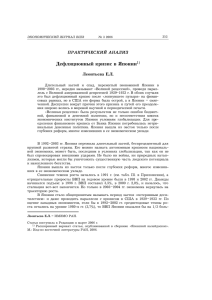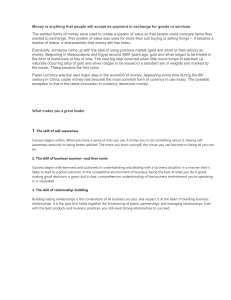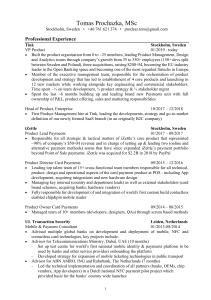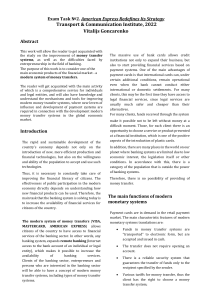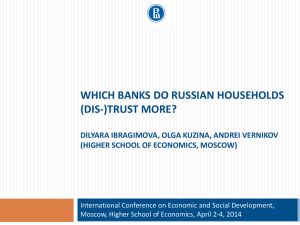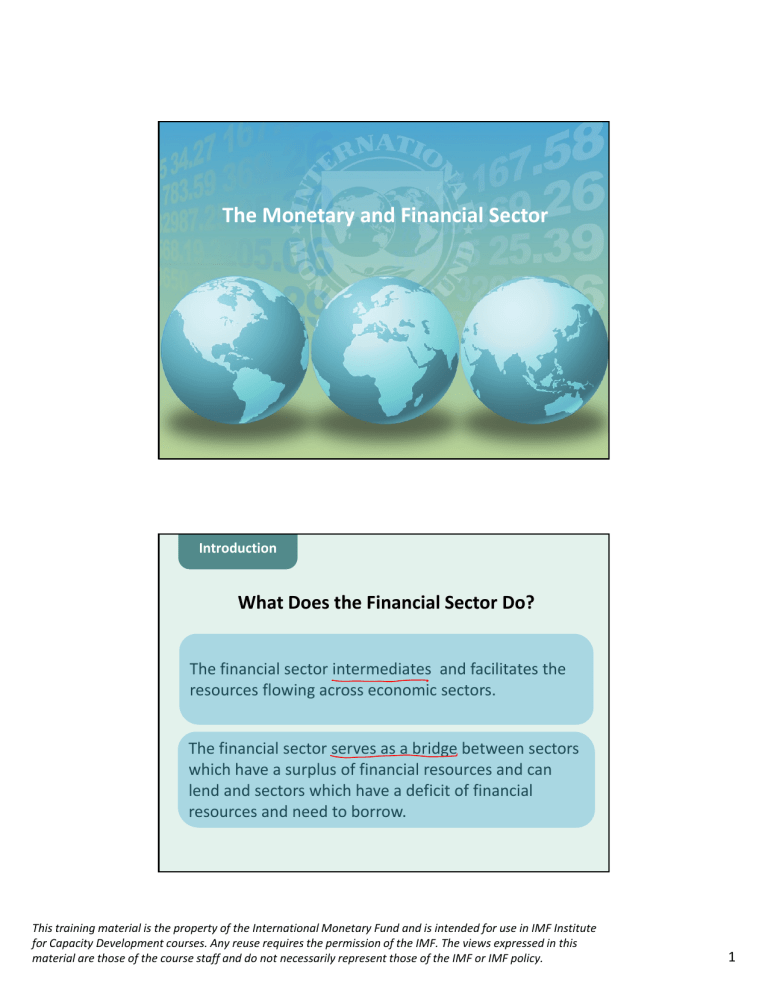
The Monetary and Financial Sector Introduction What Does the Financial Sector Do? The financial sector intermediates and facilitates the resources flowing across economic sectors. The financial sector serves as a bridge between sectors which have a surplus of financial resources and can lend and sectors which have a deficit of financial resources and need to borrow. This training material is the property of the International Monetary Fund and is intended for use in IMF Institute for Capacity Development courses. Any reuse requires the permission of the IMF. The views expressed in this material are those of the course staff and do not necessarily represent those of the IMF or IMF policy. 1 Loans Savings Households Financial Intermediaries Corporations Cash Balances Loans Introduction What Does the Financial Sector Do? It creates saving vehicles that allow for the intertemporal allocation of consumption. It creates credit instruments that allow for the allocation of savings to investment. It creates products that mitigate financial risk and therefore allow a stable income flow. 2 Introduction Monetary and Financial Sector Statistics Statistics are collected on the basis of the economic objectives, functions and behavior. The Financial Sector is the sector of the domestic economy which intermediates financial resources. The 2001 Monetary and Financial Statistic Manual is the main reference for compilation. Introduction Why are Monetary and Financial Sector Accounts Important? Financial flows mirror the flows of real resources in an economy. Monetary statistics are generally reliable and available with little delay. 3 Introduction Why are Monetary and Financial Sector Accounts Important? OU UTLIN NE The links between the monetary sector and other macroeconomic sectors play a central t l role l iin monetary t policy li d design. i Monetary and Financial Sector Statistics • Financial Sector Overview • Central Bank • Other Depository Corporations • Depository Corporations Survey Monetary Analysis • Money Multiplier • The Demand for Money • Selected Issues 4 OBJ JECTIVES Identify the main institutions composing the financial corporations sector. Understand the main items in the balance sheets of the depository corporations sector and the consolidation process. Analyze how money is created and calculate the ggrowth in the moneyy supply. Identify the main determinants of the demand for money. 1.1 Financial Sector Overview 5 The Financial Sector Depository Corporations Sector Other Financial Corporations The Financial Sector The Depository Corporations i Sector Other Financial Corporations • Central Bank • Insurance companies • Commercial Banks, Credit Unions, Savings and Loans etc • Pension funds • Money Market Funds • Mutual funds • Leasing companies and others 6 Monetary Statistics Central Bank Survey Depository Corporation Survey Other Depository Corporations Survey Other Financial Corporations Survey Financial Corporations Survey Monetary Statistics Central Bank Other Depository Corporations Depository Corporations Survey (Monetary Survey) Other Financial Corporations Survey Financial Corporations Survey 7 Presentation of the Accounts • Each account refers to one component of the financial sector. sector • It shows the stock of assets or liabilities with respect to all other sectors of the economy • For monetary analysis the flow of assets and liabilities is also important. Presentation of the Accounts The accounts are valued at fair value at the end of the reference period. All entries will be in national currency (or foreign currency in those countries where this is used as a national currency unit). 8 Presentation of the Accounts • Each account presents gross assets and gross liabilities: – by residency – by sector of economic counterparty – by type – by maturity • Some items are presented on a net basis R RECAP P – so that negative entry for a net asset is interpreted as a net liability •Financial Sector Intermediaries •Deposit Taking Institutions •Non-deposit Taking institutions •Structure of the accounts 9 1.2 The Central Bank Central Bank Functions 1 Serves as lender of last resort to the system 1. Issues currency 10 Central Bank • Role of a Lender of Last Resort : – Illiquid nature of the credit system • The liabilities of banks, such as deposits, typically have very short maturities, • The loans, that comprise the assets have much longer term. – Failing depositor confidence on one bank may lead depositors in all other banks to rush to claim their savings. Central Bank • Role of a Lender of Last Resort : – Prevent that a confidence crisis in one element spills over to the rest of the sector. • To prevent financial collapse, the central bank can: – Lend to the problem bank and guarantee payment to its depositors, 11 Central Bank Functions 1. Serves as lender of last resort to the system 1 2. Issues currency Central Bank • Role of the Issuer of the currency – Creating the monetary base (also called base money or high-powered money) • The monetary base comprises the central bank liabilities towards the rest of the system. • Through the monetary base the central banks controls the supply of money in the economy. 12 Central Bank The central bank creates monetary base whenever it purchases assets. By making a payment it writes i a check h k against i itself. Central Bank Functions 1. 1 2. 3. 4. 5. 6. Serves as lender of last resort to the system Issues currency Conducts monetary policy Holds the country’s foreign reserves Acts as banker to government Oversees the financial sector 13 Central Bank ASSETS LIABILITIES Net Foreign Assets (NFA) Monetary Base (MB) Net Domestic Assets (NDA) • • • Currency Issued Net domestic credit (NDC) • Held by public • • Held in ODC Net claims on government (NCG) • Liabilities to ODCs • Claims on ODCs (CODCs) • • Claims on other domestic economic sectors (COSE) Liabilities to the Rest of the economy included in Broad Money Other items, net (OIN) Central Bank Liabilities • Deposits of Other Depository Corporations – Each licensed bank has an account at the central bank where it holds reserves, and where credits from the central bank are deposited. – Reserves can be either required, or held on a voluntary basis (excess reserves). 14 Central Bank Balance Sheet Accounting Identity Stocks MB* = NFA* + NDA* Flows ∆MB* = ∆NFA*+ ∆NDA* Sources of Base Money Creation Net Foreign Assets Net Domestic Assets Monetary Base Net Claims on Government Claims on ODCs Claims on the Private Sector Other Items Net 15 Sources Central ofBank Base Money Creation • Open Market Operations – purchase of securities • issued by the government • Issued by the central bank • Financing of the government’s deficit – Purchases of securities – Loans • Purchases of foreign exchange Sources Central ofBank Base Money Creation • Lending to the Domestic Banking Sector – Discount window • Discount rate The discount mechanism is an instrument of monetary control 16 Sources of Base Money Creation Sterilization: – The purchase of an asset (e.g., government securities, foreign exchange) is offset by the selling of another asset – There is no impact on the monetary base, and hence on overall liquidity conditions in the economyy Central Bank: Balance Sheet Example (1): open market purchase of 100 of government bonds (from banks) Assets Net Foreign Assets Net Domestic Assets Net claims on the gov. Claims on ODCs Liabilities … Monetary Base(MB) +100 +100 Currency issued … +100 Held in banks … Held outside banks … … Claims on other res. sector … Deposits of ODCs Other items net … Other deposits +100 … 17 Central Bank: Balance Sheet Example (2):purchase of 70 of foreign currency from banks (un-sterilized purchase) Assets Net Foreign Assets Liabilities +70 Monetary Base (MB) +70 … Currency issued … Net claims on the gov. … Held in banks … Claims on ODCs … Held outside banks … Claims on other res. sector … Deposits of ODCs Other items net … Other deposits Net Domestic Assets +70 … Central Bank: Balance Sheet Example (3): purchase of 70 of foreign currency from banks, and concurrent sale of government bonds to banks (sterilized) Assets Liabilities Net Foreign Assets +70 Net Domestic Assets -70 Monetary Base(MB) Currency issued Net claims on the gov gov. -70 70 Held in banks vaults Claims on ODC … Held outside banks Claims on other res. sector … Deposits of ODC Other items net … Other deposits +70 -70 … … … +70 -70 … 18 Central Bank: Analysis R RECAP P Summary •Role of the central bank •Monetary Base •Balance Sheet Identity Sterilization •Sterilization 19 1 3 Other Depository Corporations 1.3 Other Depository Corporations The ODCs include: Commercial banks banks. merchant banks. savings and loans institutions . cooperative banks. Etc.. 20 Other Depository Corporations Functions: Collect savings from the population for safekeeping. Provide financial resources for investment purposes. Transform short term deposits into longer maturity loans. Other Depository Corporations Influence liquidity q y in the economyy through g their decisions on deposit taking and lending. Constitute the channel for the transmission of monetary policy to the economy. 21 Other Depository Corporations Survey ASSETS LIABILITIES Net Foreign Assets (ONFA) Deposits Domestic Credits • Demand • Net claims on government • Time and savings • Claims on other domestic economic sectors • Foreign currency Reserves • Required • Excess Liabilities to Central Bank Other less liquid liabilities R RECAP P Other items, net •Functions of the ODCs: • Collect Deposits • Extend Loans •Structure of the Accounts 22 1.4 Depository Corporations Survey Central Bank Other Depository Corporations Depository Corporations Survey (Monetary Survey) 23 Monetary Statistics: Depository Corporation Survey • Represents the consolidated balance sheet of the entire banking system netting out the positions between entities of the banking system. • It presents the evolution of the stock of broad money and credit developments of the banking y towards the rest of the economy. y system • It allows policymakers to adjust monetary policy, if necessary. Consolidation Central Bank Assets NFA Liabilities Base money (MB) NDA Currency issued Held in ODCs Net claims on the government Held by the public Claims on ODCs Claims on other resident sector Deposits of ODCs Other deposits Other items net ODC Assets NFA Liabilities Deposits NDA Demand deposits Claims on the central bank Time and saving deposits Currency held in vaults Foreign currency deposits Deposits at the central bank Liabilities to the central bank Domestic credit Other items net 24 Consolidated Depository Corporations Survey Assets NFA NFA of the CB NDA Net claims on the government by the CB Liabilities Broad Money Currency issued Held by the public Claims on the other resident sector by the CB Other Items net Other deposits at CB NFA of the ODCs NDA Deposits Claims on the government by the ODCs Demand deposits Time and saving deposits Claims on rest of the economy by the ODCs Foreign currency deposits Domestic Credit Other Items Net Depository Corporations Survey • Consolidates the claims of the DC sector on residents (NDA). • Consolidates the claims of the DC sector on nonresidents (NFA). • Consolidates the liabilities of the DC sector that constitute broad money (M2): • The sum of currency in circulation and transferable deposits will constitute M2, the money supply. 25 Depository Corporations Survey ASSETS LIABILITIES Net Foreign Assets (NFA) Broad money (M2) Net domestic assets (NDA) • Currency in circulation • • Transferable Deposits Domestic credit (DC) • • • Net credit to government (NCG) Claims on Resident Sector (CORS) Other items, net (OIN) • Demand deposits • Time and savings deposits • Money Market Funds Deposits • Foreign currency deposits • Other Deposits • Securities other than shares • Certificates of Deposits Monetary Aggregates • There are different definitions of the stock of y moneyy in an economy. • The most commonly used are referred to as M1 and M2, or narrow money and broad money. • M1 and M2 are the aggregates central banks most frequently monitor for purposes of monetary policy decisions. 26 Monetary Aggregates • M1, or Narrow Money is defined as the sum of: • Currency in circulation (C) • Demand deposits (D) • M2, or Broad Money, also includes: • Time and savings deposits (T) • Money Market Funds (MMF) • Foreign F i C Currency D Deposits i (FC) – These are usually referred to as: Quasi-money (QM) • So that: M2 = M1 + QM Depository Corporations Survey Balance Sheet Accounting Identity Stocks NDA + M2 = NFA + NCG + CORS + OIN M2 = NFA Flows ∆M2 = ∆NFA + ∆NDA ∆M2 = ∆NFA + ∆NCG + ∆CORS + OIN 27 Links to Other Sectors Linked to BOP M2: Net Foreign Assets NFA (NFA) Net Domestic Assets (NDA) Net credit to general government (NCG) Credit to other domestic economic sectors (CPS) Other Items, Net (OIN) R RECAP P p1 = RES = CAB*+KAB* – FAB* + NEO Linked to Fiscal Sector NCG = Domestic bank financing of fiscal deficit Linked to Real Sector CPS related to growth of: GDP, private consumption, private investment, etc •Consolidating DC Balance Sheets •Broad Money •Other sectors’ financing flows reflect in DCS 28 Slide 55 p1 Consider inserting at beginning of next section pdudine, 7/24/2013 2.1 The Money Multiplier Deposits and Reserves • The private sector will deposit a certain amount g in commercial banks for of its earnings safekeeping and saving. • The commercial banks can use part of the amounts they receive in the form of deposits to extend d lloans or purchase h assets. 29 Monetary Expansion • Money gets created when: – Commercial banks do not hold all of their deposits as reserves, but extend loans to the private sector. – The private sector will re-deposit its currency holdings into the commercial banks. • This process increases the amount of money in circulation in the economy. The Role of Reserves • Banks have to keep liquid reserves to meet withdrawal demands of their customers. • The central bank typically requires that a fraction of the reserves be deposited at the central bank: – These are known as Required Reserves • under the h Fractionall Reserve System • The reserves that banks keep in excess of requirements are known as Excess Reserves 30 Money Supply and the Multiplier Currency outside of banks + Currency outside of banks + Reserves = Deposits Base Money = Money Stock (M1) Money Multiplier • The central bank increases currency in circulation by 100 • Depositors preference for liquidity is 5 percent • Banks’ Required Reserves are 10 percent Loans $73.1 Loans $85.5 Deposits $81.2 Deposits $95 $100 Cash $5 Cash $4.2 Deposits $69.4 Cash $3.6 31 Money Multiplier • We assume depositors do not keep cash. They deposit everything they have • Assume banks only hold the reserves that are required. They lend as much as possible • Central Bank buys $100 of government bonds through an open market operation (OMO). Monetary base grows $100 • Since reserve requirement (rr) is 10%, the total amount of money (M1) will end up growing by $1000 and reserves by $100 Money Creation by Banks Money Creation: Central Bank buys from Bank A $100 of government bonds through OMO∆Base: $100 Bank A ∆Deposits ∆Credit ∆Reserves 1 2 3 4 5 6 7 … 0.0 100.0 90.0 81.0 72.9 65.6 59.0 … 100.0 90.0 81.0 72.9 65,6 59.0 53.1 … 0.0 10.0 9.0 8.1 7.3 6.6 5.91 … 32 Money Creation by Banks Money Creation: Central Bank buys from Bank A $100 of government bonds through OMO∆Base: $100 Bank A ∆Deposits ∆Credit ∆Reserves 1 2 3 4 5 6 7 … 0.0 100.0 90.0 81.0 72.9 65.6 59.0 … 100.0 90.0 81.0 72.9 65,6 59.0 53.1 … M 1 MB 1 (1 rr ) (1 rr ) 2 (1 rr )3 ... 0.0 10.0 9.0 8.1 7.3 6.6 5.91 … 1 MB 1000.0 rr 33 The Money Multiplier MB C R M 1 m m M B M1 C D m m (C R ) M1 CD mm MB CR Where: c C D r C D C D D D R D c 1 cr R D 34 The Money Multiplier • Assume r is 15 percent and c is 5 percent • The M1 money multiplier will be: • Therefore mm= 5.25 c 1 cr • Therefore if MB increases by 100 the stock of money M1 would be expected to increase by 525 The Money Multiplier • To extend this calculations to M2 it is important to keep in mind that M2 = C + D + TD + MMF according to the definition we discussed above. • Therefore the multiplier for M2 will include the public’s preference for having Time and Savings Deposits (t) and money market funds (mmf) as well as the preference for holding currency c. • It is possible to show that: mm2 1 c t mmf rc 35 The Money Multiplier • The multiplier depends on: – Reserve Requirements decided by the central bank – The banks’ opportunity cost of holding Excess Reserves • liquidity risks vis-à-vis interest rates on assets – The private sector opportunity cost of holding cash instead of deposits • liquidity risks vis-à-vis interest rates on assets Changing the Money Stock • The central bank can mop up liquidity from the economy: – by selling assets to banks • Open Market Operations – by increasing reserve requirements – by b reducing d i llending di tto b banks k 36 Changing the Money Stock • The central bank can inject liquidity in the economy: – by purchasing assets from the banks • Open Market Operations – by lowering reserve requirements – by b iincreasing i llending di tto b banks k Net foreign assets Net claims on government Claims on domestic banks Other items net Ratio of currency to demand deposits Monetary Base Reserve requirement and ratio of excess reserves to demand deposit ratio Money multiplier Broad money 37 2.2 Money Demand Money Demand Why do people hold money? 38 Money Demand Functions of Money: Medium of exchange A unit of account Store of value Money Demand 39 Money Demand Money Demand M D f (Y , P, i ) 40 Money Demand The Quantity Theory of Money MD k PY And thus k M P Y As long as k is constant, constant there is a proportional relationship between M and P 41 The Quantity Theory of Money The Quantity Theory of Money We call: v Such that: 1 k M v P Y v= income velocity of money 42 The Quantity Theory of Money The Quantity Theory of Money Taking logarithmic values: l M ln ln l v ln l P ln l Y Taking derivatives: M v P Y M v P Y v 0 v M P Y M P Y 43 The Quantity Theory of Money • Velocity is one of the most studied variables in monetary economics. • If V can be predicted with confidence – then there will be a level of the money supply that is consistent with the attainment of the desired real ggrowth rate and inflation rate. The Quantity Theory of Money • Velocity is not a mechanical link between nominal income and the stock of money – velocity and money demand are inversely related. 44 Money and Inflation • What does the quantity theory of money predict? • That h an undesired d d increase in the h stockk off money will lead to higher inflation in the economy. • Is this in the data? Money and Inflation Correlation Between Money and Inflation 40 % Change in CPI 35 30 25 20 15 10 5 0 -1 4 9 14 19 % Change in M2 Source: IFS, Fund staff estimates and calculations. Data are average growth rate in M2 and average inflation rate from 2000 to 2012. Angola has been excluded. Sample includes all IMF member countries for which both data points were available 45 Credit Growth • The quantity theory of money suggests that: – If the central bank controls the stock of money in the economy, it will control inflation. – Inflation will be controlled by limiting growth in Net Domestic Assets or in Net Foreign Assets. – If the central bank controls the growth of the monetary base it will control the growth of credit to the private sector. The Quantity Theory of Money Is velocity really constant? 46 The Income Velocity of Money • We would expect money velocity to increase if: – Expected p inflation increases – The opportunity cost of holding money increases • We would expect money velocity to decrease if: – The degree of monetization increases – Electronic money develops – Capital flows are liberalized The Income Velocity of Money • We would expect money velocity to increase if: – Expected p inflation increases – The opportunity cost of holding money increases • We would expect money velocity to decrease if: – The degree of monetization increases – Electronic money develops – Capital flows are liberalized 47 The Risk of Getting Velocity Wrong • If the central bank underestimates velocity – The excess supply of money will lead to higher inflation and/or depletion of foreign exchange reserves • If the central bank overestimates velocity – The tighter stance of monetary policy will lead to lower output growth Monetary Frameworks What are central banks actually doing in implementing monetary and exchange rage policy? • Four Viable Alternative Monetary and Exchange Rate Regimes 1. 2. 3. 4. Monetary aggregates targeting Exchange rate targeting Inflation targeting Other “eclectic” frameworks 48 Monetary Frameworks Monetary Aggregates Targeting • Th The money stock t k can b become a nominal i l anchor h if velocity is stable. • Central banks have sought to achieve the desired M2 by targeting the monetary base and hoping the h multipliers l l are stable. bl Monetary Frameworks • Since M2 = NFA+NDA – the central bank p policyy will sterilize anyy unexpected p increase in NFA or NDA. • Examples: – Industrial countries (the late-1970s to mid-1980s) – About 30 emerging market countries today (you can f the ffull list in the current issue off the IMF’s find ’ AREAER) 49 Monetary Frameworks • Exchange Rate Targeting frameworks use the exchange rate as a nominal anchor to stabilize inflation. – The central bank commits to buy or sell any amount of foreign exchange reserves at a targeted exchange rate. – EG. EG Saudi Arabia Arabia, Denmark Denmark. Monetary Frameworks • Inflation Targeting regimes use inflation expectations for a nominal anchor – The central bank targets an interest rate level that keeps the central bank’s forecast of inflation in line with a pre-announced inflation target • Examples: E l – New Zealand, Chile, U.K., Czech Republic, Poland, Romania, Thailand, Brazil, Ghana 50 Monetary Frameworks • Eclectic Monetary Frameworks – Adjust monetary policy instruments to pursue stable economic growth and low inflation, but with no formally pre-announced targets – Examples: • U.S., Euro Area, Japan, India, ... Evolution of Monetary Frameworks Evoluion of monetary regimes Advanced countries 100% 100% 90% 80% 70% Evolution of monetary regimes Emerging Markets 90% Other Inflation-targeting framework 80% 70% 60% Other 50% Inflation-targeting framework 40% Monetary aggregate target 30% 30% Exchange rate anchor 20% 20% 60% Monetary aggregate target 50% 40% Exchange rate anchor 10% 10% 0% Source :IMF, Annual Report on Exchange Arrangements and Exchange Restrictions, various issues. 0% Source :IMF, Annual Report on Exchange Arrangements and Exchange Restrictions, various issues. 51 R RECAP P •The Demand for Moneyy •The Quantity Theory of Money •Stability of the Income Velocity of Money 2.3 Selected Issues 52 Selected Issues Seigniorage. Foreign Capital Inflows. Financial Sector Vulnerabilities. Selected Issues Seigniorage. 53 Seigniorage • Rent to the central bank accruing from the privilege of being the sole issuer of currency. • The value of the printed currency is lower than the value of the central banks assets. • Important implications for monetary policy. Seigniorage • If money demand grows in the same proportion p p as real GDP . – The central bank can increase the monetary base in the same proportion without generating inflation • This is the seigniorage to the central bank. bank 54 Inflation Tax • The other component of seigniorage is the inflation tax tax. • The reduction of the value of the real value of the monetary base constitutes a revenue for the central bank (or the government). Inflation Tax • If the monetary base is 19.25 percent of GDP, a 10% inflation rate will reduce liabilities in real terms 1.9 percent of GDP. • If the velocity of money has not changed the central bank can now issue 1.9 percent of GDP in base money money. • This is the inflation tax collected by the central bank. 55 Selected Issues Seigniorage. Foreign Capital Inflows. Monetary Policy and Capital Inflows • Capital account liberalization strengthens the link between domestic and foreign economic policies • Difference between interest rates will generate a re-allocation of capital across countries. – The tightening of the monetary policy stance in a country will induce capital inflows. 56 Monetary MonetaryPolicy Policyand andCapital CapitalInflows Inflows • If countries pursue a fixed exchange rate regime: – The monetary expansion will occur as the central bank seeks to avoid an appreciation of the domestic currency. – The monetary expansion will push interest rates back down. • If countries t i llett th their i exchange h rate t fl floatt ffreely: l – The domestic currency will appreciate vis-à-vis other currencies. Responses to Capital Inflows • Accumulate reserves by buying part of the capital that is flowing into the country country, thereby allowing also some appreciation of the exchange rate. • Sterilize to offset part of the impact on the monetary base of the increased net foreign assets. • Allow an increase in the monetary base and inflation. 57 Selected Issues Seigniorage. Foreign Capital Inflows. Financial Sector Vulnerabilities. Vulnerabilities in the Financial Sector • Liquidity risk – The risk that an unexpected shock can yield to an unanticipated withdrawal of deposits deposits. • Liquidity risk is intrinsic to the banking business and stems from the maturity transformation function of the banking sector – banks are required to hold mandatory reserves at the central bank to face such risk. – banks hold extra buffers of liquidity if the economy is subject to volatile liquidity shocks. 58 Vulnerabilities in the Financial Sector • Exchange rate risk – The risk of unanticipated movements in the exchange rate yield to losses from the revaluation of assets and liabilities assets. • Exchange rate risk stems from banks’ net open position in foreign currency – The ratio of the Net Open Position in foreign currency to banks’ capital should be low. Vulnerabilities in the Financial Sector • Interest rate risk – The risk of losses from the re-pricing of assets and liabilities due to change in interest rates rates. • Interest rate risk stems from the different interest rate structure of assets and liabilities (fixed vis-afloating). – Banks hedge interest risk by building portfolios of assets to match the interest rate structure of liabilities 59 Vulnerabilities in the Financial Sector • Credit risk – The risk that loans will not be repaid • Credit risk stems from the solvency of rest of the private sector: business cycle, unemployment rate, etc. – Banks hedge against credit risk by setting aside provisions to face losses from the occurrence of defaults. Vulnerabilities in the Financial Sector • Liquidity risk • Exchange rate risk from the net open position in foreign currency • Interest rate risk • Credit risk 60 R RECAP P Monetary and Financial Statistics allow to monitor the evolution of monetary aggregates. If the h money multipliers l i li are stable bl the h centrall bank can target money supply. Money demand needs to be closely analyzed before making monetary policy decisions. Seigniorage, foreign capital inflows Seigniorage inflows, and financial sector vulnerabilities will also impact the effect monetary policy decisions. 61

